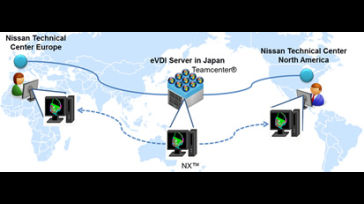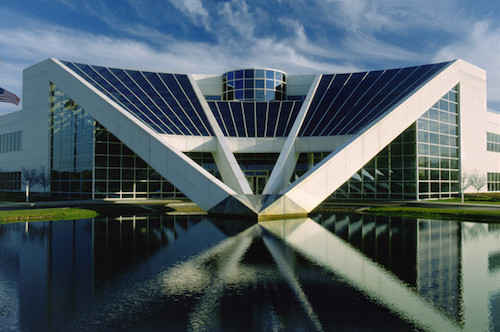VDI Takes the Driver’s Seat In Nissan Next Generation Vehicle Design Platform

Nissan’s platform adopts engineering VDI globally, utilizing servers with advanced graphics processing and high-performance storage along with Siemens’ CAD and PLM platforms. Image Courtesy of Nissan
Latest News
January 20, 2016
Designing a next-generation vehicle takes a village of software engineers, mechanical designers, electronics wizards and simulation specialists. Given the breadth of required expertise, it’s a sure bet that the village is global, not local.
Therefore, to empower its growing and global engineering workforce, Nissan is implementing a new next-generation vehicle design infrastructure built on virtual desktop infrastructure (VDI) designed to give its global R&D centers a continuous, high-speed connection to the latest vehicle data no matter where they are located.
 The Next Generation Vehicle Design Platform will initially be rolled out to Nissan Technical Centers in North America and Europe. Image Courtesy of Nissan
The Next Generation Vehicle Design Platform will initially be rolled out to Nissan Technical Centers in North America and Europe. Image Courtesy of Nissan“With the increasing number of new projects globally, IT’s importance has become even more essential,” explained Celso Guiotoko, Nissan’s CIO and head of global IS/IT in a press release. “Based on our global IS/IT strategy, Nissan will focus on linking management with IT to increase the business value IT delivers for Nissan.”
With help from partners Hewlett Packard Enterprise and Siemens AG, the Nissan Next Generation Vehicle Design Platform leverages engineering VDI technology, a combination of advanced graphics processing and desktop virtualization technology, to give Nissan engineers working anywhere around the global access to a virtual 3D CAD workstation running on a centralized server farm somewhere directly from their desktop environment. This approach allows Nissan’s engineering group to maintain the latest vehicle R&D and engineering data on its servers while still allowing teams located anywhere across the globe to access it, increasing productivity, reducing IT administration costs, and enhancing overall disaster risk management.
 Nissan’s platform adopts engineering VDI globally, utilizing servers with advanced graphics processing and high-performance storage along with Siemens’ CAD and PLM platforms. Image Courtesy of Nissan
Nissan’s platform adopts engineering VDI globally, utilizing servers with advanced graphics processing and high-performance storage along with Siemens’ CAD and PLM platforms. Image Courtesy of NissanNissan isn’t the only large-scale automaker adopting VDI. PSA Peugeot Citroën, in partnership with NVIDIA, is building out a similar VDI infrastructure, using Dassault Systemes’ CATIA V5 as the core CAD platform.
The global development platform encompasses HPE ProLiant Graphics Server Blades, for workstation-class graphics performance; HPE’s 3PAR StoreServ 7400 tier-1 storage platform; and the HPE Systems Insight Manager, a software platform used to manage the IT infrastructure and ensure system uptime.
Also included in the stack is Citrix XenDesktop Desktop Virtualization Technology and Siemen’s NX, the underlying CAD solution that will be accessible to Nissan global engineers via the new Engineering VDI solution. Siemens has certified NX on all the necessary supporting hardware, and the Teamcenter PLM solution is also in the mix to serve as a Product Data Management (PDM) backbone.
The new infrastructure will initially be launched at Nissan’s Technical Centers in North America and Europe, but plans call for the platform to be rolled out globally.
Watch this video to learn more about HPE’s virtual desktop infrastructure.
Subscribe to our FREE magazine, FREE email newsletters or both!
Latest News
About the Author
Beth Stackpole is a contributing editor to Digital Engineering. Send e-mail about this article to [email protected].
Follow DE





